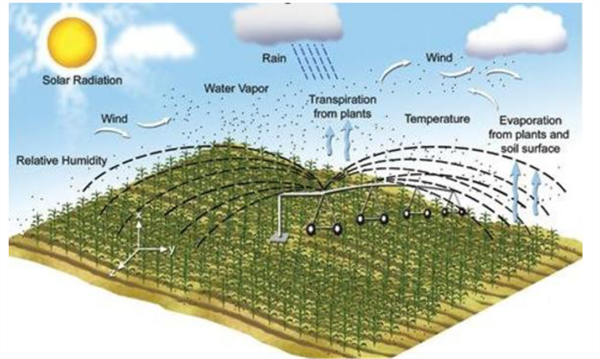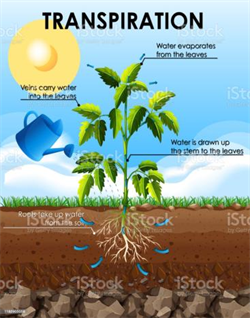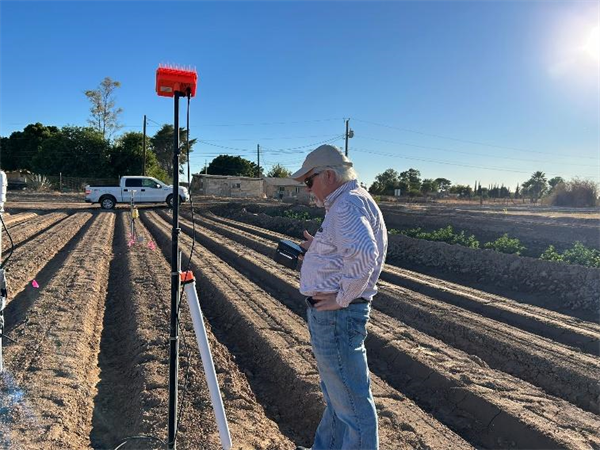
In the last issue of this UA Vegetable IPM Newsletter, I presented a melon (Cucumis melo ‘reticulatus’ L.) crop phenology model (Figure1; Silvertooth, 2025). This model can be useful in predicting and tracking crop development and identifying important stages of crop growth and development (crop phenology).
Use of a crop phenology model can be applied to basic crop management (e.g. fertilization, irrigation, harvest scheduling, pest management activities, labor, and machinery management, etc.). For use of the crop phenology model, good local weather data with heat unit information is needed. In Arizona we have an excellent weather system with the Arizona Meteorological Network, AZMET.
Since cantaloupes are a warm season crop, we use the86/55 ºF heat unit (HU) thresholds for phenological tracking. Key stages of growth or “guideposts” indicated in Figure 1represent the average or “target” values that are subject to a slight degree of natural variation, which is normal.
This melon crop phenology model was developed under fully irrigated and well-managed conditions. That is important since non-irrigated fields are more likely to experience water stress, which significantly disrupts crop development patterns.
Referring to the data from AZMET for several locations in the Yuma area, the HU accumulations (86/55 ºF thresholds) from 1 January 2025 to a set of four possible 2025 planting dates are listed in Table 1. The HU accumulations from 1 January2025 to 15 April 2025 for these sites are listed in Table 2.
The HU accumulations after planting (HUAP) for these four possible planting dates for three Yuma area locations to 15 April 2025 are shown in Table 3. The HUAP values in Table 3 are simply the difference between the values in Tables 1 and 2. An example for the Yuma Valley, 15 January 2025planting date is: HU - 73.1 HU = 645.6 ~ 646 HUAP.
The information in Table 3 can help serve as a reference to check for melon crop development in the field against this phenological model in Figure 2. Several cantaloupe/melon types are being in this region including western shipper type melons, Tuscan melons, and Hami melons. In the past, each of these melon types have tracked closely with this phenological model.
For melon crops in the lower Colorado River Valley at this time, we can expect to find fields planted and watered up in mid-January to have crown set melons beginning to develop netting, which may not be as apparent on the Hami melons. These fields could have crown fruit ready for harvesting in about three weeks, based on normal HU accumulation patterns for this time of year. For fields planted and wet dates near the first of March, these fields should be vigorously flowering.
Reference:
Silvertooth, J.C. 2025. Tracking Cantaloupe (Melon) Crop Growth and Development. University of
Arizona Vegetable IPM Newsletter, Volume 16, No.7, 2 April 2025.

Table 1. Heat unit accumulations (86/55 ºF thresholds) after 1 January 2025 on four possible 2025 planting dates utilizing Arizona Meteorological Network (AZMET) data for each representative site.
Yuma Valley: https://azmet.arizona.edu/application-areas/heat-units/station-level-summaries/az02
Yuma North Gila: https://azmet.arizona.edu/application-areas/heat-units/station-level-summaries/az14
Roll: https://azmet.arizona.edu/application-areas/heat-units/station-level-summaries/az24

Table 2. Heat unit accumulations (86/55 ºF thresholds) after 1 January 2025 to 14 April
2025 utilizing Arizona Meteorological Network (AZMET) data for each representative site.

Table 3. Heat unit accumulations (86/55 ºF thresholds) after planting (HUAP) from four
possible 2025 planting dates and three sites in the Yuma area on 15 April 2025 utilizing
Arizona Meteorological Network (AZMET) data for each representative site. Each value
is rounded to the next whole number. Note: the values in Table 3 are determined by
taking the difference between the HUs foreach representative site and four planting
dates in Tables 1 and 2.

Figure 1. Melon (cantaloupe) phenological development model expressed in Heat Units
Accumulated After Planting (HUAP, 86/55°F).
It’s unfortunately a very great season to be a plant pathologist…
We have confirmed the first sample of Fusarium wilt on lettuce submitted to the Yuma Plant Health Clinic from Yuma County. The stunted seedlings looked like any other typical case of damping-off at the seedling stage. When plated on culture media, subsequently confirmed Fusarium colonies grew abundantly from the declining plant tissues. If you’re not already on guard and scouting, this is a warning that Fusarium is active in Yuma County.
Adding on to this early alert, we’ve received a surge of submissions of young brassicas to the clinic. Several severely wilted and declining plants from around Yuma County have cultured positive for Pythium, likely as an opportunistic invader coming in on the back of all the early-season rain that brought stress to seeds and young transplants. Growers may want to consider oomycides, but only if the seedling disease is first confirmed to be Pythium. Remember, many seedling diseases caused by true fungi are indistinguishable from those caused by Pythium.
If you have any concerns regarding the health of your plants/crops please consider submitting samples to the Yuma Plant Health Clinic for diagnostic service or booking a field visit with me:
Chris Detranaltes
Cooperative Extension – Yuma County
Email: cdetranaltes@arizona.edu
Cell: 602-689-7328
6425 W 8th St Yuma, Arizona 85364 – Room 109
New automated/robotic ag technologies are coming out all the time. Ever wonder how they function in the “real world” and whether they are cost effective? Western Growers recently released a case study report on the economic impact of Stout Industrial Technology, Inc.’s Smart Cultivator on overall weeding costs. The study tracked expenses, productivity, and labor savings of the machine operating over one year on five types of lettuce crops and 2,700 acres at Triangle Farms in Salinas, CA. It is a well done, detailed study with machine costs and labor savings broken down by crop type and acreage. It’s an easy read and worth the time for those interested in the economic and overall feasibility of automated mechanical weeding. Check it out here or by clicking the image below. I don’t want to be a spoiler, but I was surprised to learn that costs for hand weeding lettuce in Salinas, CA were so high - $525/acre (conventional) and $750/acre (organic) and that in these conditions, the return on the $330K investment for the machine was less than one year when used on 2,700 acres.
Stay tuned. Western Growers plans to release four more automation technology case study reports within the next year. Upcoming reports include grower case studies experiences with the automated weeding machine from Ecorobotix; and with autonomous ag platforms from Burro, GUSS Automation, and Bluewhite. Their first report, which examined the economics of Carbon Robotics’ Laser Weeder at the commercial scale, can be found here.

Fig. 1. Western Growers case study report on the economic impact of Stout Industrial
Technology, Inc.’s weeding machine on weeding costs in lettuce on 2,700 acres at
Triangle Farms, Salinas, CA. Click here or on the figure to view. (Photo credit: The
Western Growers Centerfor Innovation & Technology)
As the weather gets cooler, aphids are migrating back to the desert to harm our crops. It is important to revisit some factors that may favor aphid infestations in your crops, specifically lettuce, and take appropriate action against them.
Nitrogen availability is one of the most important factors in the development of insect pest populations. Excessive application of nitrogen fertilizer to crops will likely increase the feeding preference and consumption rate of insect pests such as aphids, resulting in greater survival, growth, and reproduction. In some situations, high nitrogen levels in plant tissue can decrease resistance and increase susceptibility to aphids’ attacks.
Water management is also very important to consider. Excess water around plant roots can increase nitrogen uptake, which may favor an increase in the aphid population. Thus, supplying proper amounts of nitrogen and water to your crops can tremendously help with aphid management. See this link for more information on this topic.The combination of two separate processes whereby water is lost on the one hand from the soil surface by evaporation and on the other hand from the crop by transpiration, is referred to as evapotranspiration (ET). Evaporation is the process whereby liquid water is converted to water vapor (vaporization) and removed from the evaporating surface (vapor removal). Water evaporates from a variety of surfaces, such as lakes, rivers, pavements, soils, and wet vegetation. Energy is required to change the state of the molecules of water from liquid to vapor. Direct solar radiation and, to a lesser extent, the ambient temperature of the air provide this energy (Fig:1).

Figure 1: Key factors driving ET in agriculture include solar radiation, temperature, wind,
humidity, and plant and soil water loss.
Transpiration consists of the vaporization of liquid water contained in plant tissues and the vapor removal to the atmosphere. Crops predominantly lose their water through stomata. These are small openings on the plant leaf through which gases and water vapor pass. The water, together with some nutrients, is taken up by the roots and transported through the plant (Fig: 2).

Figure 2: A diagram illustrates the process of transpiration in plants, where water is
absorbed by roots, moves through the stem, and evaporates from the leaf surfaces.
Why evapotranspiration (ET)?
ET is the largest component of the hydrological cycle and is one of the most critical variables in irrigation management, crop production, and the sustainability of agriculture. It has a direct impact on water resources availability and use, water quality, and the earth’s energy balance. Daily evapotranspiration (ET) rates are needed for irrigation scheduling. The evapotranspiration rate is normally expressed in millimeters (mm) or inches (in) per unit of time (e.g., an hour, day, week, month, or even an entire growing period or year).
Reducing evapotranspiration (ET) can lead to significant water savings by minimizing unnecessary water loss through soil evaporation and plant transpiration. By applying irrigation more efficiently only when and where it's needed, plants can maintain optimal moisture levels, reducing stress and promoting better growth. This can enhance nutrient uptake, improve plant health, and ultimately lead to higher yields. Moreover, conserving water through reduced ET is especially critical in arid regions, where freshwater resources are limited, and efficient water use is essential for sustainable agricultural production.
Below are strategies to reduce ET

Figure 3: Figure 3. Soil moisture sensor installation at the Valley Research Center,
Yuma, AZ.
This time of year, John would often highlight Lepidopteran pests in the field and remind us of the importance of rotating insecticide modes of action. With worm pressure present in local crops, it’s a good time to revisit resistance management practices and ensure we’re protecting the effectiveness of these tools for seasons to come. For detailed guidelines, see Insecticide Resistance Management for Beet Armyworm, Cabbage Looper, and Diamondback Moth in Desert Produce Crops .
VegIPM Update Vol. 16, Num. 20
Oct. 1, 2025
Results of pheromone and sticky trap catches below!!
Corn earworm: CEW moth counts declined across all traps from last collection; average for this time of year.
Beet armyworm: BAW moth increased over the last two weeks; below average for this early produce season.
Cabbage looper: Cabbage looper counts increased in the last two collections; below average for mid-late September.
Diamondback moth: a few DBM moths were caught in the traps; consistent with previous years.
Whitefly: Adult movement decreased in most locations over the last two weeks, about average for this time of year.
Thrips: Thrips adult activity increased over the last two collections, typical for late September.
Aphids: Aphid movement absent so far; anticipate activity to pick up when winds begin blowing from N-NW.
Leafminers: Adult activity increased over the last two weeks, about average for this time of year.







